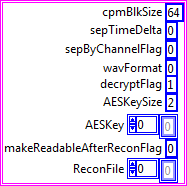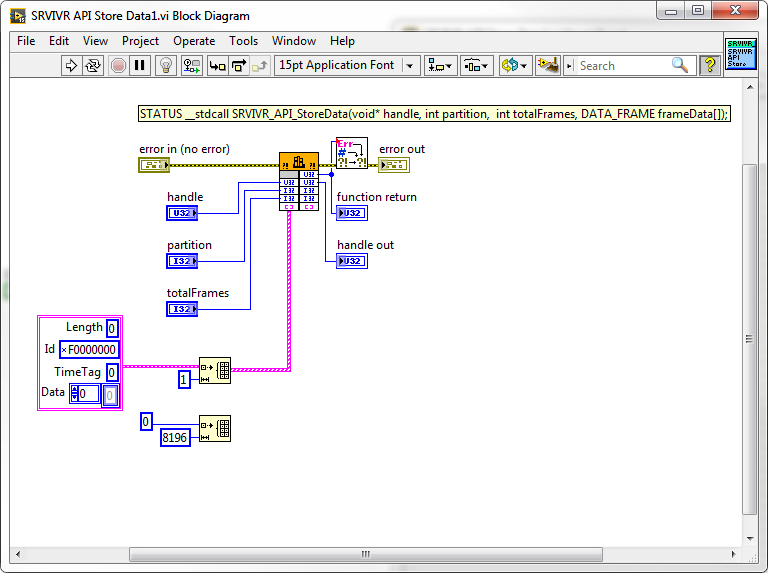-
Posts
471 -
Joined
-
Last visited
-
Days Won
20
Content Type
Profiles
Forums
Downloads
Gallery
Everything posted by viSci
-
What about the port service name locator, could that be a problem as well? I was planning on using RTI DDS for all network communications but the LabVIEW wrappers provided by RTI and now included in LV2018 have some shortcomings. Things like no native support for command-reply, no events and issues with strings within a cluster that start with a numeric digit pushed me to consider Messenger...
-
I am using cDAQ's with Linux RT but I suppose I could still use websockets, right? In the meantime I am trying out on-the-fly creation of Messenger remote connections to my cDAQs. It is not very fast ~50ms total transaction time per cDAQ but it might do since the command response side of things is more supervisory control of the overall system. For status and data collection I am using RTI-DDS which is blazing fast. One concern I am having with Messenger is that on occasion I have seen the 50ms transaction times suddenly increase to 5000ms. Shooting in the dark, I am wondering if it could have something to do with NI Service Locator sync between client and servers? Anyway, it would be nice if the messenger library had the option of specifying static port numbers instead of service names.
-
I also need something that can handle situations where the cDAQ is not present or drops out and needs to be reconnected with. I think I maybe trying to use the wrong tool for this application. I might be better off with a topic based DDS that has inherent reconnect capability.
-
Hello all - I am trying to figure out a way to use the TCP Messenger to create a PC client that can send messages to up to 52 remote cDAQs. I used your simple TCP Client Server example to start off with and it works fine for a single cDAQ server. The problem is that I do not want to have to launch 52 actors in my client code pointing to each of the 52 cDAQ IP addresses. Is there a way to just send simple messages to the server without have to launch an actor or perhaps reuse an actor by programmatically pointing to the IP address I need to talk to at any given time?
-
I use the dll wizard often and it has saved me a lot of time. It took awhile to understand how to massage the .h files into something digestible but once I got the hang of it, it was worth the effort. The error handling is pretty good at pointing you to the offending spot in the .h file. I think that the wizard has improved over time so if your last exposure was years ago I would give it another try.
-
Thanks - I was able to use your suggestion to get the current cursor position and it worked correctly. I was able to construct and insert a proper table in an open word document.
-
I would like to obtain a .net reference to an open word document and add a table at the current cursor location in the document. I can already do this using a crude automated copy and paste method but would like to be able to add a proper word table into the document. Using the .net interfaces I think this is possible but so far have not been able to get it to work. Has anyone tried to do this before?
-
Hey Neil - I am in the process of designing a 50 node (RT Linux) system with around 100 tags per node. I was briefly thinking about using NSV's or RTI-DDS but now am thinking that OPC-UA would be a better solution for publishing tag values. Do you have any performance metrics like tag updates /s for your implementation?. I have seen some pretty nice OPC UA Client Viewers that function like the NI DSM but would prefer a native LV viewer. Would you consider offering your OPC UA Viewer and Data logger as a toolkit?
-
.thumb.jpg.5d2ee2fea691c9fe3fab4270ba8e531d.jpg)
Transfer Image from cDAQ-9133 Linux RT to cDAQ-9133 WES7
viSci replied to viSci's topic in LabVIEW General
With the help of my NI inside sales rep, I was able to get a cDAQ Linux installation image and instructions to restore and existing Linux chassis or convert a WES7 to Linux. NI was very protective with this stuff even though the Linus RT source is published on GIthub. -
.thumb.jpg.5d2ee2fea691c9fe3fab4270ba8e531d.jpg)
Transfer Image from cDAQ-9133 Linux RT to cDAQ-9133 WES7
viSci replied to viSci's topic in LabVIEW General
I was told if you are within the first 30 days you can send it back to NI and they will replace it with your OS of choice. In my case that is not possible so I have to find a way to do it myself. I found this document http://www.ni.com/product-documentation/54592/en/ which alludes to being able to restore a cDAQ image or even make it a dual boot device but details are lacking. -
I have two cDAQ-9133 controllers, one with WES7 and one with LinuxRT. I would like to convert the cDAQ 9133 with WES7 to LinuxRT. Both cDAQ's were purchased 6 months ago to determine the best OS for our application. I have gone through all of the forums and it seems like I might be able to use the NI recovery disk or possibly a disk cloning utility like acronis or similar. Has anyone had success doing this?
-
Sharp LV developer needed for design / implementation of large scale distributed data acquisition system. Skills Needed: LabVIEW Real-Time, Publish Subscribe, Messaging Protocols, Data Distribution Services (like RTI-DDS, RabbitMQ, etc), DB Stored Procedures, Tree Structures, TDMS. This is a 9-12 month contract position in Gainesville, FL. Please send CV to mike.sachs@viscience.com
-
Just curious, what is the advantage of the MQTT implementation over off the shelf RTI-DDS now built into LabVIEW for windows and RT Linux
-
Can TestScript be used with Python v2.7?
-
Started putting together an example and found that the flatten and unflatten work correctly. The problem was in the file write which had the 'convert EOL' option enabled. Thanks for your help.
-
I often use variant attributes as a quick and dirty dictionary. I found out that I could flatten my 'variant dictionary' and save the flattened string to a file. I tried to unflatten the saved string and reconstitute the variant and its attributes but am getting an error 116 (Unflatten or byte stream read operation failed due to corrupt, unexpected, or truncated data.) I am using a variant constant because the variant dictionary I created has no datatype other than the attributes which are all 1D string arrays. I am beginning to think that this might not be possible to do, but thought I would check in to make sure I am not overlooking something.
-
I am looking for alternatives to using Systemlink to manage a large network of WES7 cDAQ's. I imagine there are many windows server tools out there to manage software deployment, replication, remote monitoring, etc. I am hoping someone might have some experience in this area and could offer a few suggestions on tools that would work well for the NI ecosystem but not require being an IT specialist. Thanks.
-
Systemlink was designed for such use cases. The only negative I have with it is the pricing model which is based on the number of nodes in your network.
-
Finally, It works! Sometimes a clusterasaurus is just what you need. The cluster within cluster idea is a neat trick, thanks Rolf.
-
Not sure were the 1024 comes in as AES key here is 32 bytes and the ReconFile path is 260 characters. As you said to get 260 I would have to append two clusters. Here is my latest clusterasaurus... Unfortunately this still is not satisfying the DLL. It is not blowing up but returning an error indicating an invalid parameter so I might not be too far off...
-
I like the idea of a cluster within a cluster. Is it then possible to just use an array to cluster going into a cluster bundle to add in the fixed arrays?
-
So does every *struct passed into a dll need to be flattened to a byte array? I guess in the previous case it only worked because I was passing a empty array in the cluster. So for something like this: // Structure to pass reconstruction parameters struct RECON_INFO_STRUCT { unsigned int cpmBlkSize; unsigned int sepTimeDelta; unsigned int sepByChannelFlag; //0=no, 1=yes unsigned int wavFormat; //0=mulaw, 1=pcm unsigned int decryptFlag; //0=no, 1=yes unsigned int AESKeySize; //0=128,1=192,2=256 char AESKey[CRYPTO_KEY_MAX_LENGTH_BYTES]; unsigned int makeReadableAfterReconFlag; char reconFile[MAX_PATH]; }; STATUS __stdcall SRVIVR_API_ReconFile(void* handle, char* partDataFileName, RECON_INFO_STRUCT* pReconInfo, void* pNotifyCB, void* pCBArg); Do I need to manually flatten everything to a single byte array or is there some way to use this?
-
Ok, that comment prompted me to dig some more into the IDD for the device and found that Length parameter, which I thought was the number of bytes in the data array is really the number of bytes in the data array plus 12 for the 3 long int parameters in the cluster. Once I made that change it all started working. Thanks for your help!
-
Was hoping someone might be able to give me a tip on this one... Trying to call the function below: typedef struct { unsigned int Length; unsigned int Id; unsigned int TimeTag; char Data[1024]; }DATA_FRAME; int __stdcall SRVIVR_API_StoreData(void* handle, int partition, int totalFrames, DATA_FRAME frameData[]); Here is what the import dll tool produces: This does not look correct to me and produces the dreaded 1097 exception error. I modified the call to be: Which I believe is closer to the intent of the original C function, but still gives me a 1097 error. I suspect that somehow the array pointer that the function is expecting is not correct. The frameData parameter is being passed into the function as a 'Adapt to Type', Array Pointer. I also tried flattening to a single U32 array and passing that in as an array data type but still no joy. Any ideas? BTW, I have had success calling many other functions from the dll of the form: int __stdcall func(void* handle, int param1, int param2, etc);







